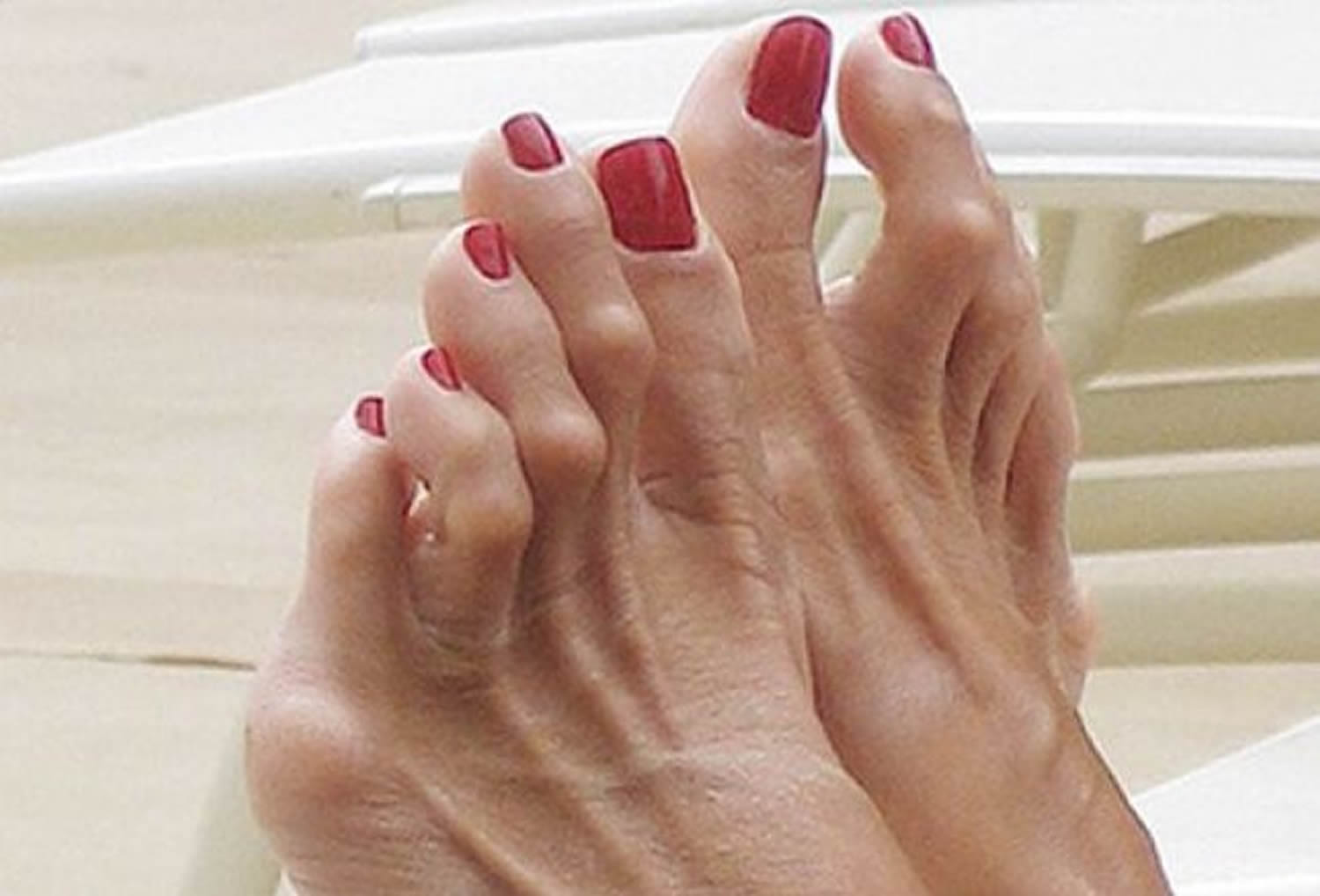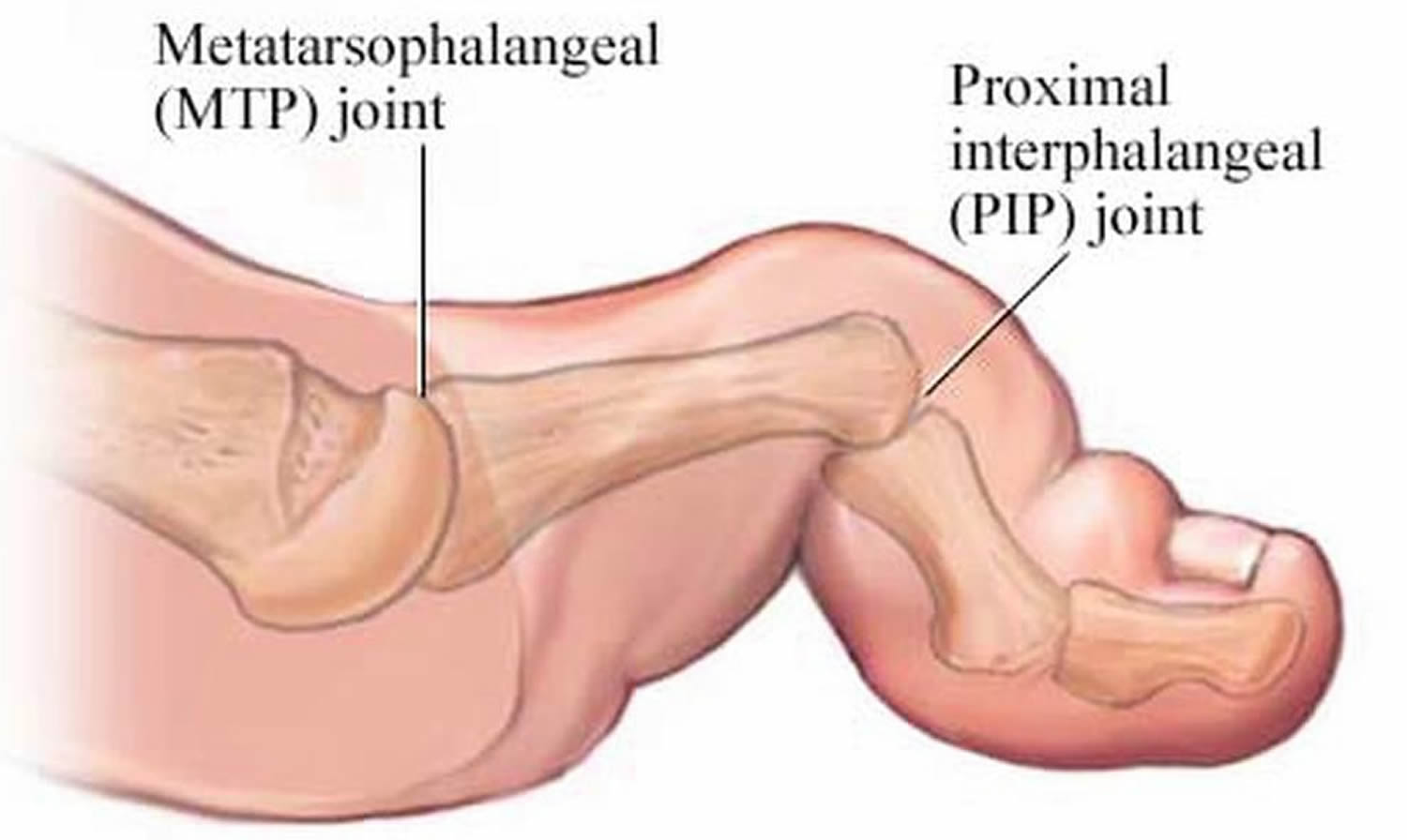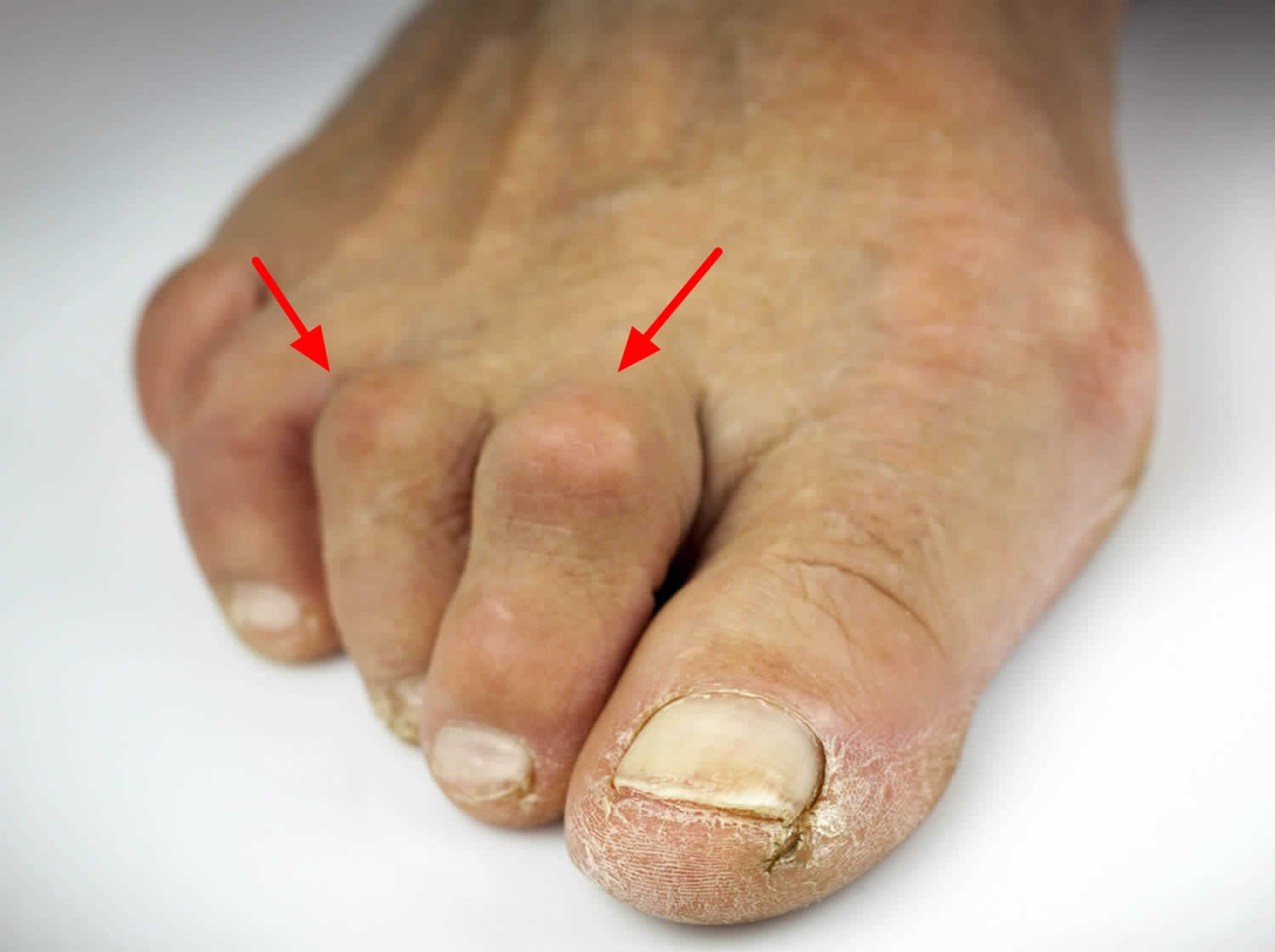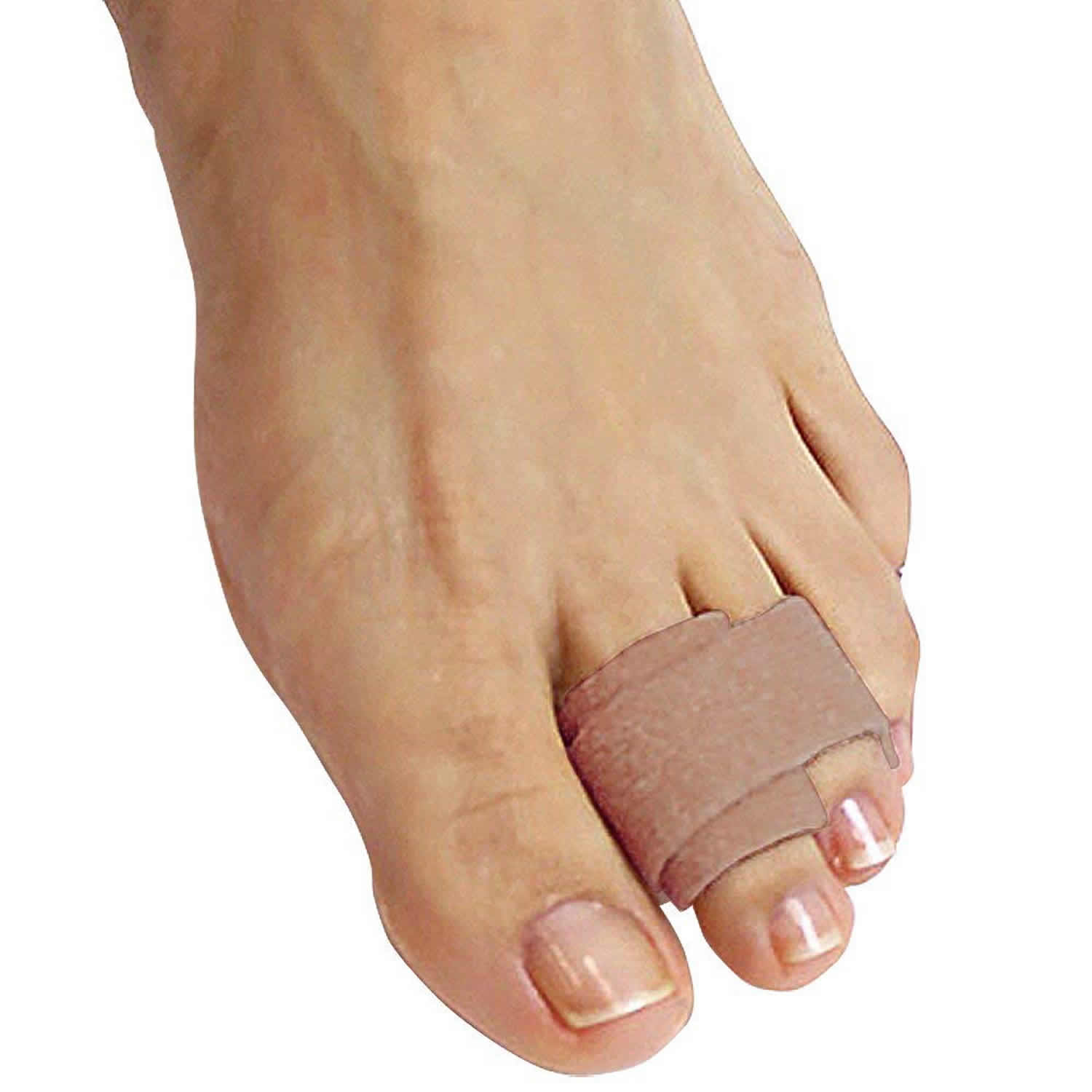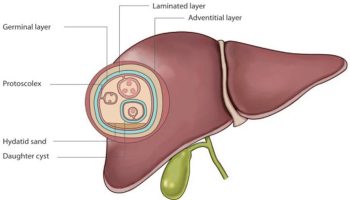Contents
What is hammer toe
A hammer toe is a deformity of the second, third or fourth toes, where one or more toes curl or bend abnormally (the toe moves into a claw-like position). With hammertoes, the toe is bent at the middle joint, so that it resembles a hammer. Initially, hammer toes are flexible and can be corrected with simple measures but, if left untreated, they can become fixed and require surgery. Hammer toe most often affects the second toe. Walking or wearing shoes can be painful.
People with hammer toe may have corns or calluses on the top of the middle joint of the toe or on the tip of the toe. They may also feel pain in their toes or feet and have difficulty finding comfortable shoes.
While ill-fitting shoes are the main reason hammer toes develop other contributing factors include; arthritis, unusually high foot arch, tightened ligaments or tendons in the foot, or pressure from a bunion. The affected joints can rub inside shoes and cause corns (buildups of dead skin).
At first, a hammer toe might maintain its flexibility. But eventually, the tendons of the toe can contract and tighten, causing your toe to become permanently bent. Your shoes can rub against the raised portion of the toe or toes, causing painful corns or calluses.
- If your hammer toe is treated early, you can often avoid surgery. Treatment will reduce pain and walking problems.
Depending on the severity of the hammer toe nonsurgical options may include:
- Properly fitted foot wear
- Toe pads or insoles to shift the toe position (hammer toe straightener)
- Gentle stretching of the toes
You can probably treat your hammer toe joint problem at home. If you start right away, you may be able to avoid surgery.
- Change your footwear. Choose shoes with roomy toe boxes, low heels, and good arch supports. Sandals or athletic shoes that don’t rub on your toe may be a good option. You could also try custom-made shoes or shoes made for people who have foot problems.
- Use products that cushion the hammer toe or hold the foot in a more comfortable position, such as moleskin, toe tubes, arch supports, or other shoe inserts (orthotics). These are better for treating a flexible toe, but they can also provide some relief for a fixed toe.
- Care for any calluses or corns on your feet. Moleskin and other over-the-counter treatments may help relieve pain. Never cut corns or calluses, because this can lead to infection.
- Take an over-the-counter pain medicine, such as acetaminophen, ibuprofen, or naproxen. Check with your doctor before taking these medicines. Be safe with medicines. Read and follow all instructions on the label.
If your hammer toe joint is flexible, you can also try:
- Taping a hammer toe. Wrap tape under the big toe (or the toe next to the hammer toe), then over the hammer toe, and then under the next toe. This gently forces the hammer toe into a normal position. But it doesn’t straighten the toe permanently.
- Toe caps, slings, or splints. These hold toes in a normal position, much like taping does.
- Hammer toe exercises that help keep the toe joints flexible and strong, such as the ones listed below. Your doctor or physiotherapist may be able to suggest more exercises.
- Gently pull on your toes to stretch the bent joints. For example, if a joint bends up, gently stretch it down. Hold for several seconds. You should feel a long, slow, gentle pull. Work on one joint at a time. Do this several times, morning and evening.
- Do towel curls. Put a towel flat under your feet and use your toes to crumple it.
- Do marble pickups. Use your toes to pick up marbles and drop them in a cup.
See your doctor if your pain doesn’t go away or it gets worse after 2 to 3 weeks of home treatment, or if you get a sore on your affected toe. Sores can get infected and lead to cellulitis or osteomyelitis, especially if you have diabetes or peripheral arterial disease.
For severe hammer toe, you will need an operation to straighten the joint.
- Hammer toe surgery often involves cutting or moving tendons and ligaments.
- Sometimes, the bones on each side of the joint need to be connected (fused) together.
Hammer toe can be corrected by surgery if conservative measures fail. Usually, surgery is done on an outpatient basis with a local anesthetic. Most of the time, you will go home on the same day as the surgery. The actual procedure will depend on the type and extent of the deformity. After the surgery, there may be some stiffness, swelling and redness and the toe may be slightly longer or shorter than before. You will be able to walk, but should not plan any long hikes while the toe heals, and should keep your foot elevated as much as possible. You may be able to put weight on your heel to walk around during the recovery period.
What does hammer toe look like
The middle joint of the toe is bent. The end part of the toe bends down into a claw-like deformity. At first, you may be able to move and straighten the toe. Over time, you will no longer be able to move the toe. It will be painful.
A corn often forms on the top of the toe. A callus is found on the sole of the foot.
Figure 1. Hammer toe
Figure 2. Hammer toe
Figure 3. Hammer toe
Hammer toe symptoms
Besides looking odd, hammer toes may:
- Hurt.
- Make it hard to find shoes that fit.
- Rub against your footwear. You may get calluses or corns where a bent toe presses against another toe or your shoe or where the toe’s tip touches the ground.
In more severe cases, hammer toe problems may affect your balance and make it hard to walk.
Hammer toe causes
Hammer toe results from shoes that don’t fit properly or a muscle imbalance, usually in combination with one or more other factors. Muscles work in pairs to straighten and bend the toes. If the toe is bent and held in one position long enough, the muscles tighten and cannot stretch out.
The most common cause of hammer toe is wearing short, narrow shoes that are too tight. The toe is forced into a bent position. Muscles and tendons in the toe tighten and become shorter.
Hammer toe is more likely to occur in:
- Women who wear shoes that DO NOT fit well or often wear shoes with high heels
- Children who wear shoes they have outgrown
Shoes that narrow toward the toe may make your forefoot look smaller. But they also push the smaller toes into a flexed (bent) position. The toes rub against the shoe, leading to the formation of corns and calluses, which further aggravate the condition. A higher heel forces the foot down and squishes the toes against the shoe, increasing the pressure and the bend in the toe. Eventually, the toe muscles become unable to straighten the toe, even when there is no confining shoe.
The condition may also be present at birth (congenital) or develop over time.
In rare cases, all of the toes are affected. This may be caused by a problem with the nerves or spinal cord.
Factors that can increase you risk of hammer toe include:
- Age. The risk of hammertoe and mallet toe increases with age.
- Sex. Women are much more likely to develop hammertoe or mallet toe than are men.
- Toe length. If your second toe is longer than your big toe, it’s at higher risk of hammertoe or mallet toe.
- Certain diseases. Arthritis and diabetes might make you more prone to developing foot deformities. Heredity might also play a role.
Hammer toe prevention
You can avoid many foot, heel and ankle problems with shoes that fit properly. Here’s what to look for when buying shoes:
- Adequate toe room. Avoid shoes with pointed toes.
- Low heels. Avoiding high heels will help you avoid back problems.
- Adjustability. Laced or strapped shoes are roomier and adjustable.
These additional tips can help you buy the right shoes:
- Buy shoes at the end of the day. Your feet swell throughout the day.
- Check your size. As you age, your shoe size might change — especially the width. Measure both feet and buy for the larger foot.
- Buy shoes that fit. Be sure shoes are comfortable before you buy them. If necessary, a shoe repair store might be able to stretch shoes in tight spots, but it’s better to buy them to fit.
How are hammer toes diagnosed?
Your doctor will ask questions about your symptoms and past health and do a physical examination. Your doctor will want to know:
- When the problems started, what activities or shoes make them worse, and if other parts of the foot are painful.
- What kind of shoes you wear and how much time you spend standing or walking every day.
- Any previous foot problems you have had.
- Any medical conditions you have that could be related, such as arthritis, diabetes, or poor circulation.
During the physical examination, your doctor will look at your foot to see if the toe joint is fixed or flexible. A joint that has some movement can sometimes be straightened without surgery. A fixed joint often requires surgery.
If you are thinking about having surgery to correct your problem, you may need:
- An X-ray to help the doctor decide what type of surgery would be most helpful.
- Blood flow testing, which may include Doppler ultrasound, if your foot seems to have poor blood flow.
- Nerve testing if your doctor thinks you have nerve problems in your foot. If this is the case, you may need to see a neurologist, a doctor who specializes in brain, spine, and nerve problems.
Hammer toe treatment
Conservative treatment starts with new shoes that have soft, roomy toe boxes. Shoes should be one-half inch longer than your longest toe. (Note: For many people, the second toe is longer than the big toe.) Avoid wearing tight, narrow, high-heeled shoes. You may also be able to find a shoe with a deep toe box that accommodates the hammer toe. Or, a shoe repair shop may be able to stretch the toe box so that it bulges out around the toe. Sandals may help, as long as they do not pinch or rub other areas of the foot.
The following changes in footwear may help relieve symptoms:
- To avoid making the hammer toe worse, wear the right size shoes or shoes with a wide toe box for comfort
- Avoid high heels as much as possible.
- Wear shoes with soft insoles to relieve pressure on the toe.
- Protect the joint that is sticking out with corn pads or felt pads.
A foot doctor can make foot devices called hammer toe regulators or straighteners for you. You can also buy them at the store.
Mild hammer toe in children can be treated by manipulating and splinting the affected toe.
Finally, your doctor may recommend that you use commercially available straps, cushions or nonmedicated corn pads to relieve symptoms. If you have diabetes, poor circulation or a lack of feeling in your feet, talk to your doctor before attempting any self-treatment.
Figure 4. Hammer toe straightener
Hammer toe exercises
Exercises may be helpful. You can try gentle stretching exercises if the toe is not already in a fixed position. Your doctor may also prescribe some toe exercises that you can do at home to stretch and strengthen the muscles. For example, you can gently stretch the toes manually. You can use your toes to pick things up off the floor (e.g., marbles). While you watch television or read, you can put a towel flat under your feet and use your toes to crumple it. Or you can use your toes to picking up a towel, which can help stretch and straighten the small muscles in your foot.
Hammer toe surgery
In general, surgery is used only for severe hammer toe problems. You may need surgery if other treatments don’t control your pain, if your hammer toe limits activity, or if you can’t move the toe joint.
For fixed hammer toe problems, doctors often do surgery on the bones. Doctors can often treat flexible toe problems by moving tendons to release tension on the joint and let the toe straighten. In some cases, the surgery for a flexible toe problem will still include work on the bones.
Your options may include one or more of the following:
- Removing part of the toe bone. This is called phalangeal head resection, or arthroplasty.
- Removing part of the joint and letting the toe bones grow together. This is called joint fusion, or arthrodesis.
- Cutting supporting tissues or moving tendons in the toe joint.
- Getting a toe implant to replace a bent joint or straighten a toe.
- In rare cases, removing the toe (amputation).
Surgery for these problems has not been widely studied and may not be for everyone. Talk to your doctor about the types of surgery and how much they might help you.
When thinking about surgery, keep in mind that:
- Surgery can reduce the pain from a deformed toe. But it may not help how your foot looks.
- Surgery has risks, including pain, swelling, and infection.
- Your toe problem may come back after surgery. This is more likely if you keep wearing the types of shoes that cause toe problems.
Hammer toe surgery risks
Risks of anesthesia and surgery in general are:
- Reactions to medicines
- Breathing problems
- Bleeding
- Infection
Risks of hammer toe surgery are:
- Poor alignment of the toe
- Injury to nerves that could cause numbness in your toe
- Scar from surgery that hurts when it is touched
- Stiffness in the toe or a toe that is too straight
- Losing your toe
